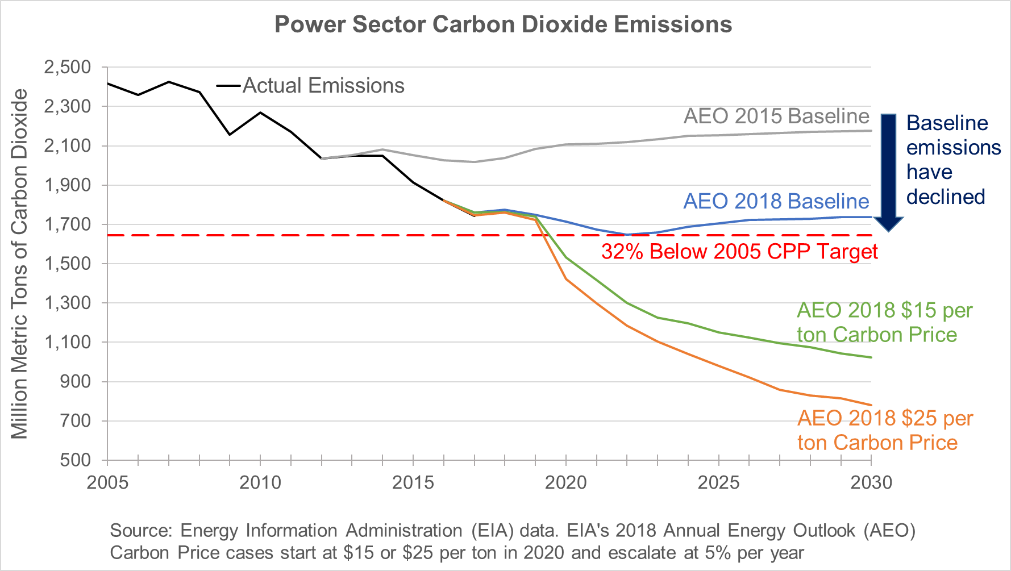Wheeler expected to weaken the Clean Power Plan even as pollution reduction costs are dropping
 EPA Acting Administrator Andrew Wheeler is reportedly taking steps to nix the Clean Power Plan– America’s only national limits on carbon pollution from existing power plants – in favor of a weak substitute that does almost nothing to protect us from climate change and would increase harmful pollution that contributes to soot and smog.
EPA Acting Administrator Andrew Wheeler is reportedly taking steps to nix the Clean Power Plan– America’s only national limits on carbon pollution from existing power plants – in favor of a weak substitute that does almost nothing to protect us from climate change and would increase harmful pollution that contributes to soot and smog.
There are many reasons why rolling back these life-saving protections makes no sense, but chief among them is that the opportunities to reduce carbon pollution are even greater – and cheaper – now than when the Clean Power Plan was finalized in 2015.
EPA is required to determine the “best system of emission reduction” when regulating pollution under the Clean Air Act, and select an approach that reflects the maximum feasible level of control. A look at the evidence overwhelmingly shows that a legitimate Clean Power Plan replacement would adopt emission reduction targets more ambitious than those in the Clean Power Plan, not less.
Here’s why:
1. Power sector trends have made the Clean Power Plan even more achievable and cost-effective than originally estimated
Since the Clean Power Plan was finalized in 2015, the ongoing market shift towards a cleaner electricity resource mix has brought the power sector ever closer to meeting the pollution reduction targets established in the Clean Power Plan.
In 2015, the Energy Information Administration (EIA) projected that power sector carbon dioxide pollution in 2030 without the Clean Power Plan in place would be 10 percent below 2005 levels. Since then, market trends have resulted in baseline emission projections declining over time. In fact in its most recent 2018 Annual Energy Outlook (AEO), EIA projected that baseline carbon pollution without the Clean Power Plan would be 28 percent below 2005 levels in 2030 – just slightly below the Clean Power Plan emission reduction target of 32 percent below 2005 levels by 2030.
To be clear, we need the long-term regulatory signal established by the Clean Power Plan in order to ensure these trends continue – and to secure the full benefits of the pollution reduction that the Clean Power Plan would require. But these projections are also powerful evidence that more ambitious targets than the Clean Power Plan can be easily and cost-effectively achieved.
2. The power industry is getting cleaner than we expected just a few years ago
Power companies and states are also continuing to press forward in their transition to cleaner electricity.
For example last summer, DTE Energy announced plans to curb its carbon pollution more than 80 percent by 2050 by closing coal-fired power plants and adding new gas-fired generation and renewables. According to CEO and Chairman Gerry Anderson, “these reductions interestingly exceed the targets established by the now shelved Clean Power Plan.”
Similarly, Xcel Energy announced earlier this year that it has already cut carbon emissions 35 percent since 2005 and is on track to achieve a total reduction of 60 percent by 2030 – far more than what the Clean Power Plan would have required.
Any replacement rule must take into account these recent trends, which indicate that it is eminently feasible and cost-effective to achieve deeper reductions than required by the Clean Power Plan.
3. Renewable energy has become more abundant and less expensive than EPA projected when crafting the Clean Power Plan
In establishing the emission reduction targets in the Clean Power Plan, EPA considered the potential to replace generation from fossil fuel-fired power plants with renewable energy, but recent cost declines and deployment of renewable energy have outpaced EPA’s expectations.
The Clean Power Plan relied on Annual Technology Baseline renewable cost projections developed by the National Renewable Energy Laboratory (NREL). Their latest 2018 Annual Technology Baseline projections show that onshore wind costs in 2030 are 28 percent lower and utility scale solar photovoltaics are 68 percent lower than 2015 cost projections used in the Clean Power Plan.
This also matches evidence we’re seeing on the ground including in recent filings from Xcel Energy, with proposals for wind between $11-18/MWh – cheaper than the operating cost of all existing coal plants in Colorado, and NV Energy, whose filing set record low prices for solar.
According to EIA’s most recent projections, renewable energy is projected to make up 23 percent of total generation in 2030. That is higher than EPA’s 2015 projections of 21 percent renewable energy generation in 2030 with the Clean Power Plan in place. And NREL’s latest projections show that, with additional improvements in the performance and cost of renewable energy technologies, the potential to deploy renewable energy is far greater than the amount EPA anticipated in setting the pollution reduction targets in the Clean Power Plan.
This evidence supports a greater potential for renewable energy to replace fossil generation and further demonstrates that more ambitious targets would be achievable and cost-effective.
4. Lower natural gas prices and higher natural gas combined cycle capacity make more ambitious pollution reduction targets possible
EPA’s approach to setting the emission targets in the Clean Power Plan took into account the potential for shifting generation from higher-emitting coal-fired sources to lower-emitting natural gas combined cycle units. Recent trends indicate that if EPA were to apply that same approach today, it would find the potential for even greater pollution reduction than was reflected in the Clean Power Plan.
Since the Clean Power Plan was finalized, natural gas prices have continued to decline, driving the ongoing shift towards higher natural gas use. In fact, the average utilization of natural gas combined cycle plants rose to 55.4 percent in 2016, slightly higher than the average utilization of coal plants.
In addition, EIA’s latest projections of the 2030 power sector delivered natural gas price (without the Clean Power Plan) is roughly 30 percent lower than projected in 2015. And natural gas combined cycle capacity also great to 240 GW in 2016 – up 30 GW from 2012, the baseline year that was used to establish the pollution reduction targets in the Clean Power Plan.
States and power companies have flexibility under the Clean Power Plan to choose the most cost-effective options for reducing pollution, including options other than shifting generation to natural gas combined cycle plants. Nevertheless, trends in the natural gas sector further indicate that more ambitious targets than the Clean Power Plan would be achievable and cost-effective.
5. Power companies have a range of options, separate from the measures included in the Clean Power Plan, for achieving deep reductions in carbon pollution
Power companies can draw from an extensive range of solutions to achieve deep reductions in carbon pollution – extending far beyond the measures that were used to set the pollution reduction targets in the Clean Power Plan.
Measures including switching from coal to natural gas or another fuel, carbon capture and storage for coal and natural gas, efficiency improvements at gas turbines, and integrated renewable energy can all help power plants achieve deep reductions in carbon pollution.
In addition, renewable technologies not considered in the Clean Power Plan, such as offshore wind and distributed solar, are now even more widely available. And cost-effective energy efficiency investments that reduce energy bills for families and businesses – though not part of the method used to establish pollution reduction targets under the Clean Power Plan – are also more readily available to power companies to comply with the Clean Power Plan.
According to the Environmental Protection Agency’s own January 2017 analysis, applying these technologies to the 2012 Clean Power Plan baseline for each state would result in emission reductions beyond the 2030 Clean Power Plan goal for nearly every state. This underscores that more ambitious targets could be cost-effectively met.
6. Recent modeling shows the cost of cutting carbon pollution is cheaper than projected – meaning EPA should be more ambitious, not less
 When EPA finalized the Clean Power Plan it found that the average cost of shifting generation to renewable energy and natural gas, to achieve 32 percent reductions below 2005 by 2030, to be in the range of $24 to $37 per ton of carbon over the 2022 to 2030 compliance period.
When EPA finalized the Clean Power Plan it found that the average cost of shifting generation to renewable energy and natural gas, to achieve 32 percent reductions below 2005 by 2030, to be in the range of $24 to $37 per ton of carbon over the 2022 to 2030 compliance period.
However the 2018 Annual Energy Outlook from the Trump Administration’s own Energy Information Administration shows that carbon emissions from the power sector can be reduced by 58-68 percent below 2005 levels – more than twice the level of reduction anticipated under the Clean Power Plan – at a cost of $24-$33 per ton in 2030. That means we can achieve significantly more reductions for less than the Clean Power Plan was projected to cost.
Other recent modeling also shows the significant potential for more carbon reductions at less cost, as compared to the Clean Power Plan:
- According to modeling performed as part of the United States Mid-Century Strategy for Deep Decarbonization, an effective carbon price of $20 per metric ton starting in 2017 and increasing at 5 percent per year, combined with successful innovation policies, leads to near-complete decarbonization of the electricity sector with wind and solar capacity additions of roughly 30 gigawatts per year between 2016 and 2035. This is significantly higher than the wind and solar maximum annual capacity growth factor of 17.8 gigawatts used in the Clean Power Plan.
- According to a recent study by the Stanford Energy Modeling Forum, all of the core carbon price trajectories modeled in the study “achieved considerably more emissions reductions than would likely have been achieved under the Clean Power Plan. This result is not surprising as the prices required to achieve the goals of the Clean Power Plan range from modest to zero depending upon the technology assumptions and model.”
- According to a recent study by Resources for the Future, “emissions reductions in the US electricity sector are projected to be less expensive than earlier analyses indicated, suggesting that emissions reduction goals can be achieved at a lower cost.” The study also found that an increased amount of emissions reductions come from shifts toward renewable generation.
If Acting EPA Administrator Wheeler decides to replace the Clean Power Plan, EPA must fulfill its legal imperative to establish carbon pollution limits that achieve maximum feasible pollution control and adequately address the urgent threat of climate change.
Together, the evidence described here indicates that more ambitious targets than the Clean Power Plan are achievable and cost-effective. By contrast, the approach that Wheeler is reportedly planning – with effectively do-nothing standards based on heat rate improvements alone – would be contrary to this evidence and fail to meet EPA’s obligations.












